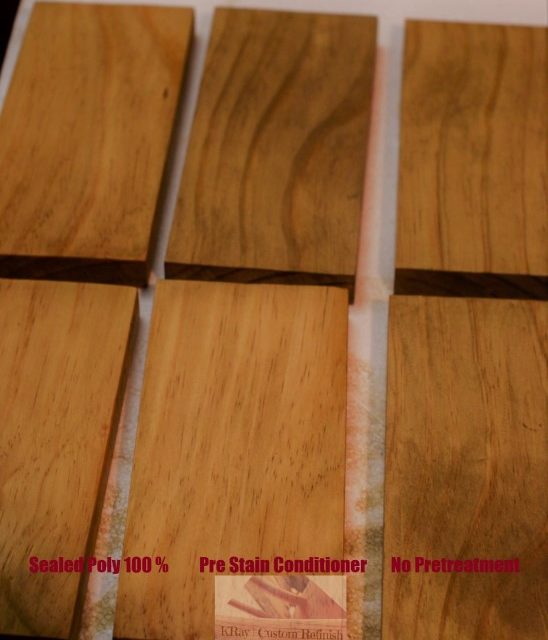**Heads up: This post contains affiliate links. As an Amazon Associate, I earn from qualifying purchases. Meaning I may receive a small commission– at no cost to you, of course– were you to make a purchase through any of the links. If I link to a product, I use it, I love it, and I think you would too! Please see my Privacy Policy for more details.
If you’ve taken a moment to read my “about me” section, you know that when I was starting, I did TONS of research. I learned everything there is to know about furniture preparation before painting, painting techniques, sanding wood, white-washing, everything!
So I decided to start this blog up to have 1 site, with ALL of that info, in one place. Of course, it’s slowly coming together, but today we’re covering a big one, Staining Wood Furniture.
First things first:
How to Stain Wood Furniture
How To Stain Wood Furniture Step by Step
If the piece is painted, strip all paint off.
Completely sand the piece down properly.
Be sure to use the correct grit for your wood type. Learn more in the How to Sand Wood Furniture post.
Choose a pre-stain method.
Wood conditioner, warm water, wipe on poly, etc. I personally always use the “popping the grain method” with warm water. If you’re using a water-based stain, this is a step you have to do before staining wood or the stain will raise the grain for you creating issues with finishing. Edit: After more research on the topic, my 100% go-to for preparing wood for staining is black tea. (click that link)
If you choose to go without a pre-stain method, at least wipe down the piece with a damp cloth or tack cloth to remove all sanding dust.
Open the wood stain and stir thoroughly.
Never shake a can of wood stain.
Using a lint-free cloth, dip one corner into the stain, and soak a small amount of stain into it.
Slowly blend the stain into the wood.
Always working with the grain.
Wait for the recommended dry time for your particular stain.
Then wipe the excess off with another clean cloth.
Slowly work your way around the piece.
Making sure you don’t do too large an area and allow the stain to dry on the wood.
Wait the recommended dry time before repeating the steps for a 2nd coat if necessary.
I go into more detail on this in the questions below.
After the stain dries completely, I recommend wiping the entire piece with a very fine piece of steel wool before applying your topcoat.
Only if using oil-based stain and topcoat. For help with topcoats, check out my newest post Repairing Damaged Wood Finishes, for info on lacquer, shellac, varnish, and polyurethane topcoats.
Now to get a little more in-depth on those steps. I’ve answered some of the most common questions that arise while staining wood furniture. If you have a question that I did not answer, PLEASE feel free to ask and I would be happy to help you.
Check out my all-new eBook “Grain – Investigating Your Furniture’s Wood Identity” if you’re not positive about what type of wood you’re working with. Identifying the wood type should always be one of your first steps in furniture restoration when planning to stain the wood.
Common Wood Staining Questions Answered
All stains are not created equal. I will be answering most of the following questions 3 times, based on either water-based stains, oil-based, or gel stains. Each type has its own different rules and guidelines to follow!
Disclaimer: I am not a professional woodworker or carpenter. I have not had any specialized training. Other than the extensive research I do on my own time, these answers are not 100% certified factual. (Although I pride myself in my research skills) I have had personal experience with all of the products I speak about in my posts, but others may have different experiences or opinions – and that is 100% A-OK with me! Just please be sure to read the directions or speak with a certified professional before attempting any of the projects discussed in this article if you are unsure. And always follow proper safety procedures!
Should I Use a Pre-Stain Conditioner on the Wood Before Staining Wood?
This is a tricky question. In truth, it really depends on what type of wood you are staining, and the look that you’re going for. If you prep easily stainable wood correctly, you shouldn’t need the wood conditioner.
Hard to stain woods like pine and maple; you may want to use it to prevent blotching. This will diminish the coloring, and wood grain, so you would need to weigh the pros and cons of each piece individually.
Once again if you’re not sure about the wood type of your piece, make sure you check out my eBook or read my Ultimate Guide For Identifying Wood Types in Furniture.
I personally am not a fan of pre-stain conditioner because I try for the most wood grain possible, and conditioner just takes too much of it away. Check out when I tested out a few alternative pre-stain methods for more.
Always, at the very least, raise the grain of the wood before applying water-based wood stains.
Do this by using a spray bottle of water to coat the surface of the wood lightly. Spread it evenly with a paintbrush or cloth. Then let it completely dry (usually about 30 minutes or so.)
Once dry, take 400+ grit sandpaper and very lightly sand off the rough “fuzzies” that have appeared on the surface. Those “fuzzies” usually only appear once, so when you apply the water-based stain, they won’t pop up and ruin your nice smooth surface!
For oil-based and gel stains, my favorite pre-stain treatment method is Black Tea. But it’s not a requirement.
You can read how I discovered this method in Preparing Wood For Staining, my 2nd pre-stain treatment method experiment.

How Much Wood Stain Do I Need to Use?
These take the longest to dry, so you can work a larger area at once without the excess drying up. I still recommend using a small amount, dip a corner of your lint-free rag in the stain, soak it and let the excess drip off before placing it on the wood.
Water-based stains dry extremely quickly. Therefore, you should only use enough to cover a small area – small enough that you can go back and wipe off the excess within 2-3 minutes. Otherwise, the excess will dry on top of the wood and become blotchy and uneven.
A gel stain is more like paint than a stain in my opinion. You are dedicated to at least 3 coats no matter what when working with it. The first coat should be decently thick and even.
Use a foam brush, not a rag, and coat the entire area at once. It really doesn’t get rubbed in like the other two, it just sits on top. So if you think of it more like paint, you should get the amount I’m talking about.
Related: Unique Wood Finishing Techniques to Make Your Furniture Stand Out
How Long Should Wood Stain Be Left to Dry Before Applying the Next Coat or Topcoat?
Under normal circumstances, you should wait 24 hours for the stain to dry. Depending on the environment, you may not have to wait for the full 24. If it is a hot, dry day you can get away with 6-8 hours.
If your next coat is Polyurethane you have to be careful, if the stain is not completely dry, the poly may end up pulling up some of the colors with it when applied. That will cause spots that are lighter than others and blotchiness.
It’s best to take your time and wait for the full 24 hours. Rushing things never seem to work out in woodwork I’ve found!
These stains dry much faster than oil-based stains. If the excess will dry within 2-3 minutes then the whole thing won’t take much longer, right? It’s best to wait at least 3 hours before the next coat, or topcoat under normal circumstances.
Gel Stains: Wait for 8 – 10 hours before applying another coat of stain. For the topcoat, wait at least 24 hours.
Why is the Wood Stain Still Tacky After Waiting the Recommended Dry Time?
Occasionally, you’ll find that no matter how long you wait – the stain is still tacky to the touch. If the temperature and humidity levels were correct during the application, that means either: the piece was not sanded down enough in the beginning, or there was too much stain used during the application.
If the coats of stain were too thick, the wood couldn’t absorb the stain correctly. This leaves the excess stain on top, unable to completely cure. Try lightly wiping down the piece with a rag soaked in mineral spirits. This should remove the excess stain, and allow the leftover to cure properly.
You can either leave the piece for another 24 hours to dry, or lightly sand it, and apply another coat of stain using much less stain. On the other hand, if the wood was not sanded down enough, and had a previous finish on it, the stain wouldn’t be able to penetrate the wood due to the old finish blocking it.
Your best option would be to sand the piece completely – including the old finish – to bare wood and re-stain the piece.
How Do I Get Rid of the Wood Stain Smell?
The most common reason for the lingering smell of stains and chemicals is poor ventilation during the application. That doesn’t quite help you if you’ve already applied the stain, but for future applications make sure to do the work in a well-ventilated room with fans for circulation, or outdoors. This is especially important to stop the smell from spreading to other objects in your home.
You can also try using water-based stains over oil-based as they tend to smell less. If you’ve already applied the wood stain and still smell the chemicals, try finishing with an encapsulating water-based topcoat. This is completely fine to use over oil-based stains as long as you wait for 48 hrs minimum before applying it.
How Do I Clean Up and Dispose of Rags and Brushes After Staining Wood?
Oil-Based Stains and Gel Stains:
Normally, I would use a lint-free rag or cheesecloth to apply oil-based stains. I love cheesecloth as it comes in a long roll that you can cut a small amount off of, and save the rest. Then when you’re done staining you can dispose of the small piece.
Proper Disposal of Oil-Based Stain Rags:
The safest practice is to place the rags in a metal container with a lid (old paint can perhaps?), filled with water. Then schedule a pickup, or bring them to your nearest hazardous waste facility.
You can also wet the rags with water and lay them out flat to dry, on a concrete or dirt floor out of the sun. Once they are completely dry – about 3 days or so, you can dispose of them normally
Cleaning Oil-Based Stain off of Paint Brushes:
Tip 1: BEFORE Using Oil-Based Stain on a Paint Brush, dip the brush in mineral spirits. This will make for a MUCH easier cleanup.
Tip 2: if you plan to reuse the brush the next day to finish up, you can soak the brush in mineral spirits overnight.
Just make sure the brush isn’t sitting on the bottom of the container or the bristles will be damaged.
If you choose to use a paintbrush to apply your stain and would like to reuse it, your best bet is mineral spirits.
Place the brush in a metal container and fill it to just above the bristles of the brush.
Mix the brush around in the mineral spirits, and use a brush comb to brush through the bristles. This allows the mineral spirits to hit the inner bristles of the brush.
Next, squeeze all of the mineral spirits out of the brush, and apply dish soap, or a lanolin-based hand cleaner my favorite:
Do the same with the brush comb and then squeeze all that you can out of the brush.
You will need to repeat these steps 3-4 times to get that oily feel off of the brush. Rinse with warm water, and hang the brush to dry before placing it back in the cardboard cover it came with when purchased.
Water-Based Stains:
These are much easier cleanups. Rags, foam brushes, or paintbrushes can be easily cleaned up with dish soap and warm water. I personally like to use a lanolin-based hand cleanser as well, which if you leave a bit on the brush to dry will make it stay super soft for your next use!
Which Stain Type Would You Recommend For Tough To Stain Woods Like Maple, or Pine?
100% use a Water-Based Stain or Wood Dye for tough to stain woods. They work wonders on keeping away any blotches or unevenness. They take a little getting used to as they dry very quickly. But once you get it, your wood stain projects will be gorgeous!
One Last Wood Staining Tip
If you’ve only used Minwax stains, and are still having trouble, try out Zar Wood Stains. Their stains have controlled penetration– which basically means it stops streaking or uneven spots from popping up while staining. No matter what it seems like your piece comes out perfect every time with Zar, no exaggeration.
Hopefully, this has helped solve any issues you might be having while staining wood furniture.
To keep this info on hand, print out my free Staining Wood Cheat Sheet with Dry Times, Application Ideal Conditions, and Cleanup Specs for each type of stain.

or
Click Here for your free download!
If you’re still having trouble staining, you may need to go back to the start.
Make sure that the wood was sanded (5 Game-Changing Tips) and treated correctly before you began staining.
Learn about my new favorite Black Tea Pre-Stain Treatment Method – it works every time!

Thanks for reading!
Until Next Time,
KRay




How do you feel about ECOS stain and varnish? I’m very sensitive to chemicals, even with a mask. I’m also looking for a safer varnisher. I have tried Citristrip stripping gel. I’m not to sure if I like it. I want to ask you after you strip your furniture what do you use to filler the small holes. I read somewhere you should use wood dust and mix it with wood paste to get the color that match your piece, because it hard to stain over wood. How can I get a got result using ECOS stain and varnish, using a safe striper? Do you have a book to recommend?